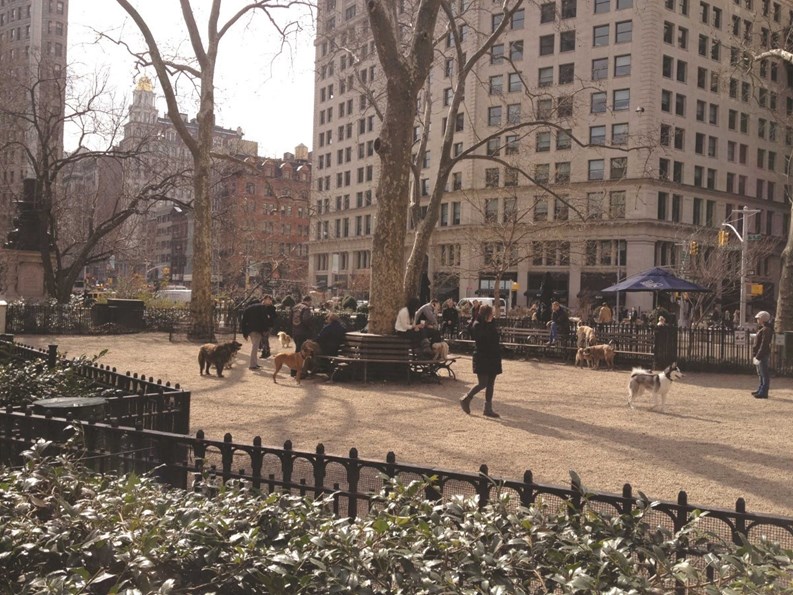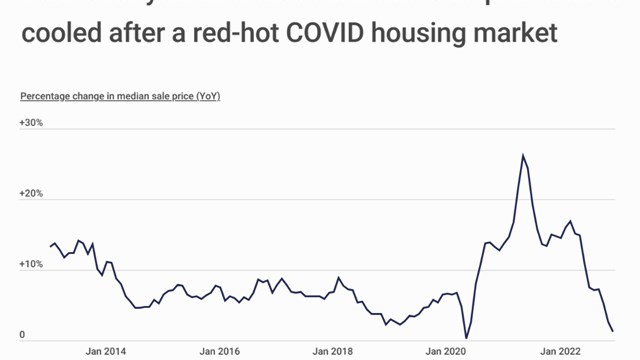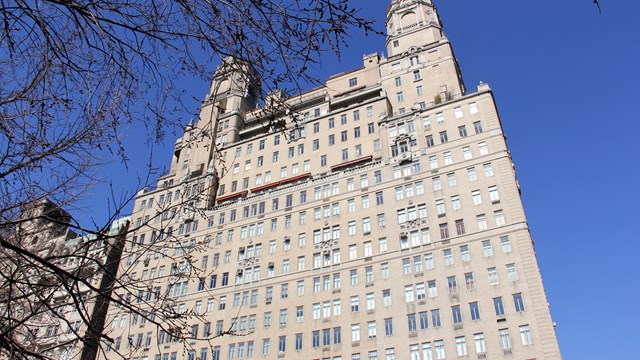It’s no secret that New Yorkers love their dogs. In 2011, there were more than 1.4 million dogs in New York City, according to www.nycoffleash.com. With a pack like that, it’s no wonder businesses and city dwellings are jumping on the dog-service bandwagon.
If you're the proud owner of a noble hound, you know what an important part our canine counterparts play in both day-to-day and larger life decisions we make. Where to live? Why to live there? And with more and more, What’s in it for Fido? The easier a co-op or condo building can make it on dog owners to care for their pooches given the hectic pace of most New Yorkers, the more attractive the community. So the 53 off-leash dog runs located around Manhattan may play a larger role in the demographics of a particular neighborhood or building.
If You Build it, They Will... Fetch
A sure-fire way to attract this market-share is to develop near city green spaces that exist or have the potential to create dog friendly off-leash areas. New York City has leash laws which require dogs to be leashed at all times, with the exception of certain designated areas—many of which are dog runs.
The first urban dog run in New York City appeared in 1990 in Tompkins Square Park. It was built as part of the effort to resurrect the dilapidated park—which for years had been overrun with vagrants and drug-related mayhem—and to give dog owners a place to bring their pets for some hard-to-come-by city exercise space. The popularity of this dog run grew enormously over the ensuing years, and it recently underwent a $450,000 renovation, the funds for which were raised both by patrons of the dog run and by city government.
At the helm of the big refurbishment was Brad Romaker, the New York City Parks Department's director of capital projects for the borough of Manhattan.
“I have somehow become the ‘dog run’ guy,” says Romaker, and it's not hard to see why. He has put his stamp on dog runs all over Manhattan, including St. Nicholas Park, Morningside Park, Carl Schurz Park, DeWitt Clinton Park and the Highbridge Parks, to name a few. The dog run at Tompkins Square is not only popular all year round, but boasts such notable events as the the biggest 'dog Halloween party' in the U.S. Every year, hundreds of pet owners and their pooches dress up in all manner of festive attire and make the scene to show off and help raise funds to care for and keep the city's dog runs maintained.
Building a Better Dog Park
According to Romaker, “Before a community can be 'awarded' a dog run or dog run renovation by the Parks Department, the community must form a group board.” This board takes administrative responsibility for everything inside the dog park fence, while the Parks Department will maintain and remove garbage from the containers located outside of the run.
Designing modern dog runs necessitates consideration for the dog owners as well as the dogs themselves. In urban areas especially, human socialization plays a large a role in a successful dog run. Relationships are inevitably forged when humans and their pups meet at the same time day after day, so it’s important for owners to be comfortable as they watch their dog frolic with his pals, not to mention the casual spectators who come to watch as well.
Today’s dog runs are built with vestibule-type entrances. This is a double opening where one gate opens by either sliding or swinging out so that it may be closed before entering the area where the dogs are.
Shaded and sheltered spaces provided by trees inside the run tend to be the most popular hangouts for owners. “Whenever you have trees in a dog run, you have to protect the roots,” says Romaker. “Dogs run in constant circles, and that can actually cause damage to the roots of the tree.” His design offers a deck built around the base of the tree to keep the ground from being worn away by so many paws doing laps.
Dogs' Rules
For safety reasons, small and large dog separation is very common in urban dog runs. In most runs, the small dogs are limited to animals 23 pounds and under. Puppies that will grow to be larger than that, but are still under the 23-pound mark are generally asked to use the large dog portion of the run, though exceptions are sometimes made for very young puppies.
Dog owners can relax while their pooch releases some pent-up energy. As part of the Tompkins Square redesign, the wrought-iron fence now matches the rest of the park's historical look, bringing function and form together.
The turf used in dog runs is also a key ingredient. Paw-friendly crushed stone or sand seems to be the choice du jour, but asphalt covered in a painted-on material called 'sports coat' is used in some parks, such as the dog run just below Christopher Street near the West Side Highway. The crushed stone option is a safe material that doesn’t turn into mud when wet and is comfortable for the animals to play on but it does need to be raked and evened out on a regular basis. The asphalt is virtually maintenance-free, with the exception of an occasional power wash.
A common turf-choice misstep among early dog run designs was the use of mulch or wood chips. This material can prove costly as it needs to be replaced often thanks to enthusiastic dogs kicking the material outside the fence and exposing the bare surface underneath.
Most urban dog runs now offer at least one area where running water is available, although some of the larger and more popular runs have a few stations. These areas are there not only to help keep the dogs clean, cool and hydrated but also supplement maintenance and cleanup efforts. Depending upon the type of turf in the run as well as access to water, hosing down the area in the evenings a couple times a week can assist in keeping things looking their best. Where water is available the city keeps it running from May through October.
Arpad Baksa, owner of Arpad Baksa Architect, PC, says “One of the most important elements in the design and maintenance of a successful dog run is non-porous, non odor-trapping materials.” While researching design elements of a dog run he is designing for Union Square, “people consistently stated odor as the number one deterrent in NOT utilizing a dog run,” he says. Summertime in New York City can be offensive to even the most hardened city dweller’s nose. Dog runs need not add to that offense.
Keeping a well-maintained dog run is important to all who want to enjoy the park. “The folks who use the dog runs generally come up with schedules for cleaning and maintenance among themselves.” says Baksa, “and having a maintenance shed on site makes it that much easier for people to adhere to the schedule.” A small shed or storage bin large enough for a few rakes, shovels, garbage bags and various hose attachments generally does the trick.
Along with odor high up on the maintenance-concerns list is pet waste—and growing numbers of dog runs now offer free waste removal and pickup bags. Staying on top of this type of cleanup is of the utmost importance in odor reduction and general park cleanliness.
Aside from the obvious daily maintenance, the city's urban dog parks are remarkably maintenance-free. Clearing leaves in the fall and snow in the winter from the inside the fenced area is really the only seasonal concern, says Romaker. “Part of the design is to have the space be virtually maintenance-free. If the dog owners follow the posted rules as to conduct, and the maintenance duties are fulfilled by the folks who use the park, Mother Nature should take care of the rest.”
At the end of the day, dog owners are drawn to these spaces so their pets can have some valuable off-leash fun and exercise each day. Like their human counterparts, dogs want to socialize, have fun and play and dog runs are outlets for them to do just that in a safe, well monitored environment.
For more information on how to start the process of building a dog run or getting a dog run renovation in your area visit www.nycgovparks.org or dial the city’s hotline at 311.
David Garry is a freelance writer and a frequent contributor to The Cooperator.







Leave a Comment